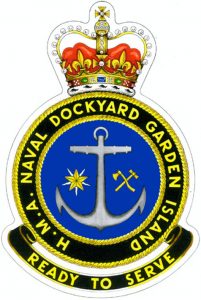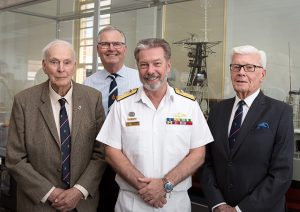- Author
- Rivett, Norman C
- Subjects
- None noted
- Tags
-
- RAN Ships
- None noted.
- Publication
- June 2018 edition of the Naval Historical Review (all rights reserved)
Norman (Norm) Rivett is one of the longest serving members of the Garden Island fraternity and now aged 93, after a total of sixty-three years spent at the Island, is finally hanging up some well-worn boots. Norm hails from the harsh northeast of England – a Geordie born and bred. He served his apprenticeship as a fitter and turner at Parsons, the world renowned builder of steam turbines, and later joined the merchant navy serving as a ship’s engineer with the Ellerman Lines. Not wasting time, Norm passed the demanding examinations for Chief Engineer in steam and motor ships.
During a call at Sydney a friend introduced Norm to Patricia (Pat). Two years later Norm married Pat and settled here. In 1956 he took on a temporary job in the machine shop at Garden Island Dockyard. Norm never left the dockyard, eventually becoming a Senior Technical Officer before retiring in 1986. Well before this, in 1970 Norm became an inaugural member of the Garden Island Historical Society, later renamed the Naval Historical Society (NHS).
On his so-called retirement the then General Manager, Rear Admiral Nigel Berlyn, asked Norm if he could assist in looking after the dockyard’s historical collection – the forerunner of the Naval Heritage Collection. So Norm stayed and we at the NHS and the Navy at large owe much to this hard working, dedicated and humble man. Pat having passed away, Norm now lives with his daughter Louise. It is with sadness that we say farewell to Norm and Louise and wish them every happiness for the future – but just in case he has a change of heart we can always find a place at Garden Island.
It is with the greatest of pleasure that we publish Norm’s swansong, an aptly titled article Ready to Serve.
No discussion or accountof the post Second World War history of HMA Naval Dockyard Garden Island would be complete without acknowledging the role played by the Garden Island Social and Sporting Club (GIS&SC) in creating a sense of esprit de corps. The GIS&SC was founded in 1945, it is not recorded who conceived the idea but it was probably a member of the original committee which had as its first President Mr. Les Robinson.
There had been other clubs on the island previously but these were separate and unrelated to each other. The GIS&SC was entirely self-supporting and totally independent of the Dockyard management with whom relations were always cordial. The patron was usually the Flag Officer East Australian Area and the vice-patrons the Dockyard General Manager and other senior Dockyard or area officers. The committee was elected annually by the members and represented a good cross section of the workforce, with females always included.

The club provided something of interest for everyone and most of the dockyard personnel were either members or supporters of it. Membership was not confined to the dockyard personnel as it also included those in outlying stations. The GIS&SC comprised a number of individual clubs with their own elected office bearers; their activities covered bowls, darts, football, soccer, cricket, basketball, table tennis (but oddly there was no tennis club), swimming and water polo (in the early years there was a swimming pool at the northern end of the Island). Other clubs were ten pin bowling, camera, kennel, rifle and golf clubs and later the Garden Island Historical Society. There were also group activities such as theatre parties, trips to places of interest, sports days, dances in the staff canteen, and the annual Formal Ball.
The highlight of each year was the children’s Christmas Party which involved the whole family and required a great deal of organisation by the Social Committee and their volunteers. Fond memories of these Christmas Parties are still recalled by those who attended either as children or parents, as they did much to unite the workforce, which reached its post war peak at about 3,500 men and women. Tribute must also be paid to the RAN for the services of the Navy Band and on one occasion Lieutenant Tom Fisher, who was on the General Manager’s staff at the time, arrived by helicopter dressed as Father Christmas. Years later, as Commodore Tom Fisher, he returned as General Manager.
In December 1949 the GIS&SC established what was to become a quarterly magazine entitled, unsurprisingly, Garden Island,which reported activities of the various clubs and the dockyard personnel, engagements, marriages, births, retirements and deaths etc. Copies of the magazine were circulated throughout all Sydney establishments for an annual subscription of £2.00, including postage (there was no actual charge made to Dockyard employees). Mr. Lewis (Lew) Lind came to the dockyard in 1966 as Public Relations Officer. A journalist by profession, he soon began to write historical articles for Garden Island, becoming Assistant editor in April 1969 and Editor in April 1970; the following month he founded The Garden Island Historical Society.
Raising funds to sustain these multitudes of activities involved a year round effort by the Social Committee and in addition to the modest annual membership fee of £3.00, on each pay day (wages were paid in cash in those days) there was a sale of chocolate bars and toffees. However the big attraction on pay day was the lottery which was held during the lunch break at the entrance to No. 1 Boiler Shop.
The raffle ticket butts were placed in a revolving barrel, designed and manufactured by the boilermakers, and given a good whirl before one of the female staff was asked to draw the winning number. There was always a large crowd at this event. Despite the rugged nature of their employment the boilermakers were a likeable and sociable group and were always well represented on the GIS&SC Committee and prepared to lend a hand whenever required.
Garden Island Dockyard already had a reputation for long service by its employees where two generations of a family was commonplace and three generations not unusual. The prime example of this was the Hawkins family:
- Alfred Charles Hawkins joined the dockyard as a moulder in 1900 and became the dockyard’s first Foreman Moulder in 1904. He retired in 1939 after 39 years service.
- Alfred had four brothers, all of whom served in either the dockyard or the RAN, some did both.
- Brother Charles served in the RAN during WWI, joined the dockyard in 1918 and retired in 1963 as Foreman Moulder after 45 years service.
- Brother Mac served in the RAN and briefly in the dockyard in 1955.
- Brother Harold served in the RAN from 1926 until 1945 with a short break in 1936.
- Brother Milton served in the dockyard from 1927 until 1932, probably leaving due to lay-offs during the Great Depression when the dockyard lost many good men and the ‘lucky’ retainees worked one week in five, undoubtedly the dockyard’s darkest period.
- The two Hawkins brothers were followed by their sister Lynette in 1956 when she joined the dockyard drawing office as a drafting assistant (tracer).The final length of service of these younger Hawkins are still unconfirmed but the period of Roy and Milton’s apprenticeships alone would take the family record of service in the dockyard to the century mark.
With the commencement of WWII and steady employment, long service became the norm; e.g. forty-two years service by Wilfred Hansford, Head Foreman Fitter and Wally Lambert, Head Foreman Boilermaker, forty-five years by Charles Hawkins, BEM, Foreman Moulder, forty-eight years by Douglas Grant, BEM, Project Superintendent and by Jack Ferguson, Superintendent Mechanical Engineer, forty-nine years and ten months by Steven Stout, Electrical and later Purchasing Officer, and the longest by Richard Towns, BEM, Civil Personnel Section, fifty years less one day, as retirement was compulsory on the day prior to a sixty-fifthbirthday.
These are but some of the employees known to me. Sadly not all of Garden Island’s finest lived to reach retirement age, e.g. Walter (Wally) Atkinson, Naval Architect, Gerry Amy, Refit Superintendent, Jack Martin, Head Foreman Boilermaker, Jack Taylor, Head Foreman Fitter and Harry Chadwick, Foreman Fitter Afloat, to name but a few of my acquaintances.
Such lengths of service no longer appear possible under the present circumstances of management and ownership. How many of this generation will be able to claim to have spent the whole of their working lives in the one job and enjoyed it? The late Jack Thompson, Senior Civil Personnel Officer and former naval man, was fascinated by the tendency for long service at the Island and undertook research using personnel files. His conclusion was that staff either came to Garden Island for a lifetime or a Dog Watch and if they left they often returned and went the distance.
Garden Island Dockyard was indeed a special place to have worked and to be ‘Ready to Serve’ there was a privilege enjoyed by many.





